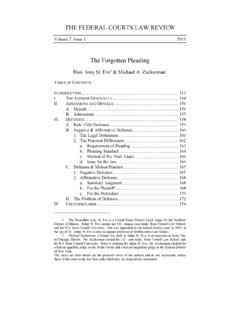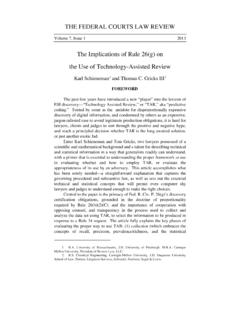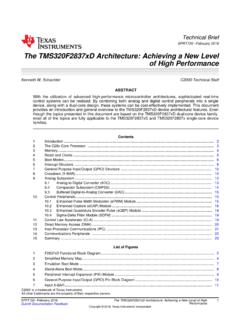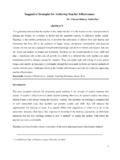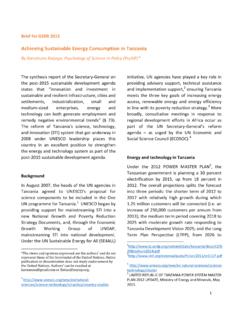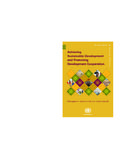Transcription of THE FEDERAL COURTS LAW REVIEW
1 THE FEDERAL COURTS LAW REVIEW Volume 9, Issue 2 2015 A Practical Guide to achieving Proportionality Under New FEDERAL Rule of Civil Procedure 26 Hon. Elizabeth D. Laporte Jonathan M. Redgrave1 Table of Contents I. ABSTRACT .. 20 .. BRIEF HISTORY OF PROPORTIONALITY IN THE FEDERALRULES (PART I: 1937-1983) .. 24 BRIEF HISTORY OF PROPORTIONALITY IN THE FEDERALRULES (PART II: 1983-PRESENT) .. 29 V. 2015 PROPOSED RULE 26(B)(1) AND 39 FAILURE TO MASTER PROPORTIONALITY (1983-PRESENT) .. PROPORTIONALITY MATRIX METHODOLOGY: A GUIDE FORACHIEVING MASTERY OVER PROPORTIONALITY ASSESSMENTSAND ARGUMENTS.
2 47 BEST PRACTICES FOR COUNSEL (AND CLIENTS) TO BETTERUNDERSTAND AND APPLY PROPORTIONALITY FACTORS Laporte is a United States Magistrate Judge for the United States District Courtfor the Northern District of California. She serves on the Board of Governors for the Northern California Chapter of the Association of Business Trial Lawyers and the Executive Committee of the Litigation Section of the Bar Association of San Francisco. She is also a judicial observer for The Sedona Conference Working Group on Electronic Document Retention and Production.
3 Jonathan Redgrave is a partner with Redgrave LLP in Washington, He is Chair Emeritus of The Sedona Conference Working Group on Best Practices for Electronic Document Retention and Production. The views expressed in this article are solely those of the authors. The authors express their thanks to the efforts of many over the last few years who assisted in discussing the ideas in this document and/or drafting or revising various sections of the article. The authors especially thank France Jaffe, a senior attorney in Redgrave LLP s San Francisco office, for her tireless dedication to help us bring the drafting process to its final conclusion.
4 20 FEDERAL COURTS LAW REVIEW [Vol. 9 CIVIL DISCOVERY DISPUTES .. 51 .. 71X. APPENDIX .. 73 I. ABSTRACT The exponential growth of electronically stored information and the challenges it imposes on parties in civil litigation have increased the need for counsel to understand and effectively navigate proportionality arguments. Yet, few attorneys have mastered this aspect of civil achieving proportionality in civil discovery is critically important to securing the just, speedy, and inexpensive resolution of civil disputes, consistent with the edict of FEDERAL Rule of Civil Procedure 1.]
5 Despite periodic changes in the civil discovery rules since 1980 to address claims of excess, burden, and abuse as well as to provide explicitly for electronic discovery respected authorities continue to express dissatisfaction with the handling of discovery issues and disputes. Arguably, much of this continued frustration is rooted in the perception that preservation and production burdens are not proportional to the lawsuits that generate the discovery. The authors submit that much of this frustration stems from the failure of attorneys to master the proportionality concepts embedded in the civil rules.
6 In this article, the authors explore the evolution of proportionality in the civil rules and jurisprudence, as well as the criticism engendered by the ongoing failure of parties and their counsel to properly implement those rules, which in turn impeded the development of a coherent and predictable body of case law, frustrating practitioners and their clients. The authors conclude that the failed promise of proportionality is rooted in the absence of the consistent and explicit consideration and presentation of proportionality arguments and objections.
7 In this context, the authors recognize the renewed call for greater attention to proportionality in new state rules of civil procedure adopted in Minnesota and Utah since the beginning of 2012, as well as the emphasis on proportionality in proposed changes to the FEDERAL Rules that, absent congressional action under the Rules Enabling Act, will become effective as of December 1, 2015. This renewed consensus regarding the critical role of proportionality in civil discovery underscores the need for attorneys to master proportionality guidance developed in this article is equally applicable under the existing FederalRules as well as analogous state rules governing discovery under state law.
8 2015] achieving Proportionality 21 arguments. The authors propose a new approach to mastering proportionality: a uniform set of practical considerations drawn from the current and proposed civil rules that attorneys should address when considering proportionality issues in discovery. This proposed approach necessarily requires a focused and standardized application of this methodology to assess, raise, and argue proportionality in discovery disputes. The authors contend this methodology will increase counsels certainty when framing arguments.
9 Moreover, the authors further contend that this methodology will leave less room in discovery disputes for extended forays into purely ideological debate while providing much needed consistency for COURTS in understanding and addressing the disputes. If adopted, this methodology could standardize the approach to proportionality in discovery in the same manner that the factors enumerated in Rule 23(a) have led to a largely standardized approach to class certification briefing and decisions.
10 Finally, the authors submit ten best practices drawn from their studies, analysis, and years of experience. These are intended to present practical ways to consider and apply proportionality in civil litigation. The authors believe that the true promise of any proportionality rules can only be realized by a change in practice (and culture) that must be learned and enforced. 22 FEDERAL COURTS LAW REVIEW [Vol. 9 concept of proportionality in discovery was formally embedded inthe FEDERAL Rules of Civil Procedure in At that time, Rule 26(b)(1)(iii) was amended to address the problems of discovery that is disproportionate to the individual lawsuit 4 and the perceived tendency of litigants to abuse the discovery process in order to attain a tactical advantage.]


